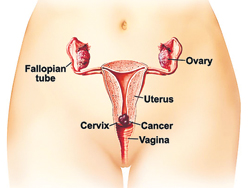
| Cervical cancer: Catch it early In Sri Lanka, cervical cancer is the commonest cancer in the female reproductive system. 19% of all female cancers are cervical cancers, says Gynaecological Cancer Surgeon and Director, Cancer Hospital, Dr. Kanishka Karunaratne. "As we do not have adequate screening, many are detected in the advanced stages," Dr. Karunaratne states. Currently, there are about 1500 cases of cervical cancer detected annually, but there could be more. Some women opt for native treatment and hence are not documented in medical registers.
How is cervical cancer caused? 99% of cervical cancers are caused by a sexually transmitted virus called the human papillomavirus. Dr. Karunaratne says there are 60 groups of HPV out of which five to six sub types are involved in the development of cervical cancer. A few others can cause a condition called benign virus warts which develop in the reproductive system of the woman raising the risk of cancer. The human papillomavirus enters cells in the cervix (neck of the womb), multiplies and mutates the nucleus of the cells. If infection becomes chronic, with repeated exposure, it progresses into cervical cancer. Cervical cancer is preventable: The good news is that cervical cancer is preventable. It can be detected by a simple test, a pap smear whereby a scraping from the cervix is examined in a lab to identify abnormal cells which are produced due to HPV infection. The painless procedure should be done ideally once in three years. Incidence: Globally, 500,000 cases are detected annually out of which two thirds of patients live in developing countries, most of which do not have adequate screening facilities due to financial and other constraints. In developed countries that have a well organized screening system the incidence of cervical cancer has been reduced by at least 70 - 80%. Who is at risk? It is more prevalent in women aged between 35-60, a time in their life when they bear many responsibilities. Once infection sets in, it takes about 5-10 years for the cancer to develop. Warning signs: In the absence of symptoms, the condition goes unnoticed more often than not. Hence, one needs to watch out for warning signs such as discharge from the birth passage which can have a purulent smell; bleeding in between menstrual cycles and bleeding after sexual intercourse. If the cancer spreads to the ligaments around the womb, it can cause backache. In extreme situations, a sufferer can pass blood in urine and stools. Diagnosis: Diagnosis is done through a pap smear. The final confirmation is done by taking a biopsy of the growth or ulcer at the cervix. Types of cervical cancer: While Squamous cell cancers account for 90% of cancers, Adino cancers, Clear Cell cancers and Undifferentiated cancers account for 10%. Treatment: If abnormality is found in a pap smear, a patient would need to do a special test called the Colposcopy test using a magnifying instrument which helps to locate the abnormality. The abnormal cells are excised and removed to prevent cervical cancer occurring in the future. When diagnosis shows that cancer has already developed, it is treated in two ways: 1. Early cancers that tend to spread to lymph nodes can be treated by surgery that involves removing the womb and upper part of the birth passage. 2. Chemo-radiation - This method uses both chemotherapy and radiation to shrink and eliminate disease from the cervix. When diagnosed in an advanced stage, chances of survival are around 50% after five years. Prevention: While primary prevention involves raising awareness amongst the public about the problem of sexually transmitted diseases, the need to avoid multiple sexual contacts and the importance of safe sex by use of condoms is vital. Secondary prevention deals with diagnosis through pap smear to locate abnormal cells. Screening Programme: With the help of the United Nations Population Fund (UNFPA), the Ministry of Health is currently implementing a limited screening programme in a few areas. The pap smear programme is being introduced through the concept of well-woman clinics which address common female disorders such as diabetes, blood pressure and breast examination. Still in its infancy, the programme would help patients with abnormal cells to be referred to hospitals where there are colposcopic facilities for further treatment. They would require plenty of backup facilities, man power, and finances to fully address the issue, Dr. Karunaratne says.
|
|| Front
Page | News | Editorial | Columns | Sports | Plus | Financial
Times | International | Mirror | TV
Times | Funday
Times | MediScene || |
| |
Copyright
2007 Wijeya
Newspapers Ltd.Colombo. Sri Lanka. |
